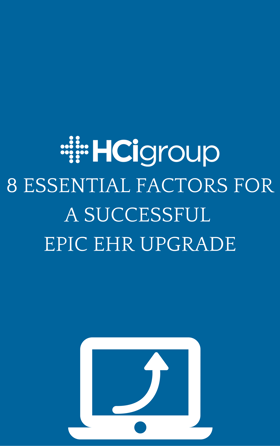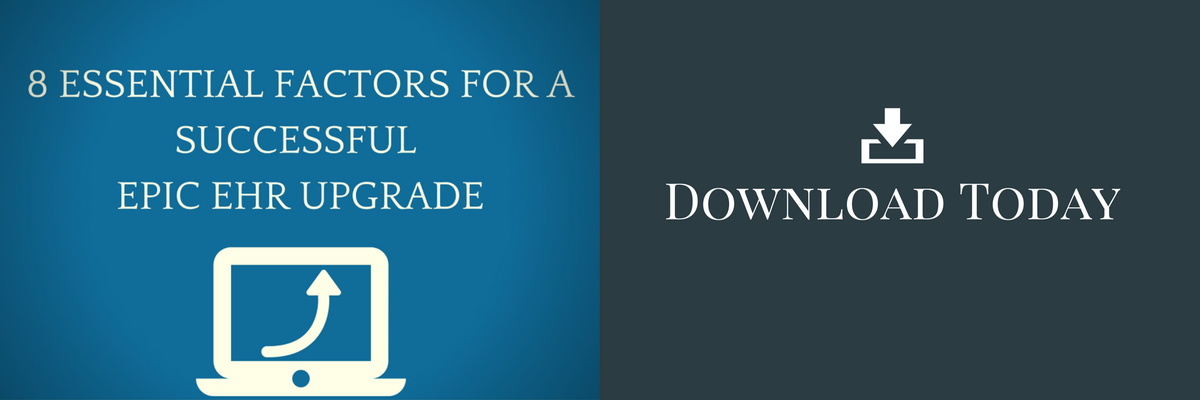8 Essential Factors for a Successful Epic EHR Upgrade

 "But we just installed the system, now you're saying we must upgrade?!"
"But we just installed the system, now you're saying we must upgrade?!"
For maximum EHR (Electronic Health Record) ROI to be achieved, regular upgrades are needed. Continually reaping the benefits of your EHR investment requires you to commit to both the optimization and maintenance of the system, well beyond the initial Go-Live. Major EHR upgrades require significant investments of your finite time, labor, and budget resources.
In this article we will discuss challenges that you will likely face and ways in which the HCI Group can help.
These upgrades require diligence and discipline to keep current with the Epic’s release schedule. In addition to helping you to realize the benefits of software maintenance and to retain membership in Epic’s Good Maintenance program, implementing the latest functionality available also provides you with the framework for complying with regulatory and compliance requirements (e.g. – Meaningful Use).
You should plan to execute a major upgrade every 12 to 18 months to stay current with Epic‘s release of major versions of its EHR. Each upgrade takes six to nine months of planning, testing, training, execution, post-upgrade support, and optimization.
1) Budget and Planning
You must accomplish more within the limits of your health IT budget because it is unlikely to increase significantly, even with competing priorities. Budgeting to upgrade your EHR could siphon funds from other time-sensitive projects, such as integrating your health IT systems with those of a competing organization that you may be acquiring.
You will also encounter resistance to change among your Epic EHR’s users, particularly if they experienced problems with the initial installation of the system and/or any subsequent updates. Defining your needs holistically by querying representatives from multiple departments and levels of leadership will likely elicit opposition.
How HCI Helps – Staffed with experienced healthcare CIOs, program directors, and financial analysts, HCI’s advisors can help you develop a comprehensive budget for your Epic EHR upgrade that will not impair progress on other health IT projects. Our advisors also bring experience assisting other organizations with Epic upgrades and draw upon industry best practices.
2) Epic Project Director
Managing an Epic upgrade is a full-time position. An internal health IT manager cannot direct the project while fulfilling their other duties.
Nor is an IT manager necessarily qualified to handle changes to clinical workflow, just as a care provider could not reasonably be asked to assume responsibility for technology upgrades. The training associated with implementing an Epic upgrade requires yet even more expertise. Your project director should be able to simultaneously manage changes to your applications and infrastructure as well as the training for using the new system.
Solution – HCI’s EHR program directors have led numerous upgrades. They can lead you through your upgrade, or simply provide the much needed bandwidth for your Project Management Office to lead the charge, giving your internal project director the time they need to manage the upgrade by diverting non-related responsibilities to other team members. Hiring an HCI EHR program director experienced in Epic upgrades could also be beneficial because they could bring best practices that could improve patient care while saving your organization time and money.
3) Epic Release Note Guidance
Knowing the improvements that the newest version of the Epic EHR includes is essential in maximizing the benefits of upgrading. Major system enhancements like new capabilities for labeling breast milk or integrating with a blood bank will only help you if you know that they are there and how to use them properly.
If you do not review Epic’s release notes, or grasp all of the details, then you could fail to implement the functionality that would be most useful because an upgrade could affect every aspect of your organization, from outpatient care to revenue cycle management. You could also overestimate or underestimate the effect of implementing a particular change on any one department, or across several collectively, thereby wasting your resources and diminishing your ROI.
How HCI Helps – Cross-certified Epic analysts can guide you through the detailed review of Epic EHR release notes, providing recommendations on what to accept or defer. These subject-matter experts (SMEs) can also facilitate a a smooth release cycle by applying their substantial upgrade experience.
4) Resource Augmentation
Your internal health IT staff alone may have indeed updated your Epic EHR. But updates typically require 2,000 hours of work—whereas an upgrade could take upwards of 13,000 hours.
Is your IT staff large enough to complete an upgrade? And without dropping other projects, either by choice or from necessity? If not, you could experience costly implementation delays.
How HCI Helps – You can use our Epic analysts to backfill capabilities for internal resources who are working on the upgrade. Or, you could hire Epic analysts to help you transition to the latest version while your internal team works on non-related projects. Either way will ensure that your resources are ample and aligned.
Additional resources that may be of interest to you:
- 5 Epic Upgrade Cost Considerations
- Epic New Version Training and Upgrades: Our Top 3 Tips
- Epic Implementation Guide

